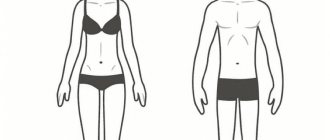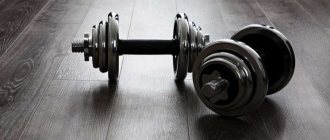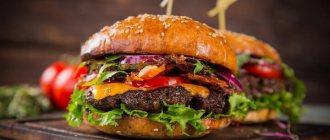If your goal is developed and voluminous muscles, then you should start with mass training. Learn how to create a muscle building program!
Why do you need a weight training program at all? Can’t you start drying right away? But you can’t! To show off voluminous and defined muscles, you first need to pump them up. In this article we will tell you what your basic mass training program should be and what rules you should follow to gain quality muscles.
Any training program for muscle mass must include a clear exercise schedule, a balanced diet, the best foods for mass, and sufficient recovery time. Moreover, this set of recommendations is radically different from the so-called drying - the period of working out the relief.
It is important here not to confuse the types of training, because the price of a mistake is quite high: you can lose the muscles you gained so hard and waste a lot of time and money. To prevent this from happening, it is enough to remember the basic principles of weight gain.
According to the structure of the content. For each training day, a video of the following format has been prepared, as well as a training module with a complete list of exercises with video instructions for the technique.
All you have to do is try out all the suggested tips in the gym on yourself and set a goal.
Principles of a muscle mass training program
Gaining muscle mass is the main goal of men who come to the gym. Its achievement depends on many factors.
How much to train
The duration of one lesson in the gym should not exceed 1 hour. If you exercise longer, you will become overtired and begin to burn muscles. The break between sets should last 1-4 minutes, this is enough to recover. An excessively long rest period can reduce the effectiveness of the exercise - the muscles will return to their original state, which was before the start of the workout.
How often to train to gain mass?
There are also certain requirements for the rest period between workouts for certain muscle groups - at least 72 hours. Hence the recommended frequency of training - no more than four per week: 3 strength and 1 light recovery.
Every workout involves breakdown of muscle fibers, depletion of key nutrients, and, of course, fatigue. This leads to a decrease in functionality. From this starting point, your body will recover by increasing muscle protein synthesis to rebuild muscle tissue, bringing you back to baseline as quickly as possible. If recovery is normal, a period of supercompensation occurs, during which your functionality exceeds your baseline level. This means that your muscles are growing faster than before.
Thus, for one muscle group you do the following training from the third to the eighth day. Exercising more frequently will put your body into overtraining mode.
The base is the head of everything
Just as a reliable house is impossible without a foundation, so perfect relief is unattainable without a strong muscular frame. Do you want to become huge? Do a basic weight training program! It is on this basis that you will build voluminous muscles in order to subsequently sharpen their relief in training.
“Basic” are multi-component exercises that train several muscle groups at once, while isolating exercises work only on one. Start the first stage of training (1-3 weeks) with basic exercises - deadlifts, squats and bench press, and then move on to building individual muscle groups in the second stage (4-6 weeks) using a split program according to:
- increasing the volume of the biceps,
- pumping the legs,
- building shoulder muscles
- back pumping.
At the third stage of gaining muscle mass (7-9 weeks), you can additionally begin detailed work on the trapezius, triceps, forearms and other smaller muscles. Now let's look at the second training session of the base period.
Reps and sets for bulking
The optimal range of repetitions of one exercise in a set is 6-12, in total there should be no more than three such approaches (or sets). Work in a relaxed manner, concentrating on correct technique. Why rush? Gaining mass requires a thoughtful and thorough approach, while neglecting technique leaves its mark on the speed of achieving results and its quality.
Moreover, not only beginners, but also some experienced bodybuilders are guilty of this. Be smarter and work exclusively for results.
Use free weights
An effective training program for gaining mass must certainly include work with free weights, because it is exercises with weights - with a barbell and dumbbells - that promote active muscle growth. Just don't let your muscles get used to a certain weight, otherwise they will stop growing. Increase your working weight, but remember: you need to do this gradually.
Let's look at the third training session of the base period.
Shock is our way
Every 3-4 weeks, make some changes to your program so that your muscles do not have time to adapt and become stressed from the unusual load. You can increase the intensity of your classes, add new exercises, increase the load, etc. Constantly expand your knowledge on methods of influencing the body and pumping muscles.
Recovery and muscle gain
This may surprise you, but muscle fiber growth occurs not during training, but during rest. This means that high-quality muscle hypertrophy can be achieved only by following a recovery regime. Proper muscle recovery after training is one of the keys to your success in your chosen goal. Consider massages and foam roller exercises for this.
Protect your muscles from overexertion and give them time to recover. The ideal option is to choose a program that uses one muscle group no more than once a week. This way you will gradually work your entire body without overloading.
The key to high-quality weight gain is a training program chosen wisely and taking into account the characteristics of your body.
Our recommended mass gain training program is suitable for intermediate to advanced bodybuilders. The training plan is designed for 6-8 weeks.
Lean muscle mass. Is it possible to dial?
I had to experiment a lot, study and try, but, in the end, I was able to identify for myself a few basic rules in order to gain muscle mass and look quite lean at the same time.
Here are the main ones:
- There should be ENOUGH calories, BUT NOT EXCESSIVE ! This process must be strictly controlled. Theoretically, you should get exactly what you need to build your muscles, and there should be no excess so that the body does not store them in the form of fat deposits. In practice, this is VERY HARD to implement, because... Calorie consumption is influenced by many factors: how you slept, how much training you did, how nervous you were, what foods you ate, how high your metabolism is, how much muscle is in your body, etc. It is practically impossible to accurately calculate sufficient, but not excessive, calorie consumption every day. Therefore, be prepared that you will walk a very fine line and keep either “one foot” in conditions of anabolism, or “the other foot” in conditions of catabolism. In such conditions it is VERY DIFFICULT to type! You will either lose muscle or gain muscle. There will be progress, but very slow. There is no need to expect fantastic results.
- In order for muscles to grow, you need to provide the muscles with a heavy load (in the range of 6-12 repetitions), i.e. There is no talk of pumping. Many people, when on a diet, begin to greatly reduce working weights and work in high repetitions. This is a mistake if you want to preserve the maximum amount of muscle, because under such conditions the body WILL NOT SEE THE NEED for maintaining muscle mass. The ideal option, from my point of view, is 4-6 approaches with a slightly lower working weight (weight will fall in any case on a low-carbohydrate diet), and then 1-2 approaches in pumping mode to further fatigue the muscles ( for 10-15 repetitions).
- It will be easier for a beginner to gain leanness at the beginning of his training journey than for a more trained athlete. Yes, gaining weight in a calorie surplus WILL HAPPEN BETTER because it ensures that you have enough calories and nutrients (the body stores the excess). Therefore, reasonable obesity is even beneficial here. BUT! At the very beginning, the muscles of beginners change, mainly NOT DUE TO HYPERTROPHY (the weights are small, so the load is insignificant), but due to the transformation of various systems in their body (endocrine, accumulation of nutrients, nervous, etc.), efficiency changes energy consumption. Therefore, the muscles will look more full. YOU WILL GAIN WORSE, BUT IT IS POSSIBLE TO GAIN SO MUCH at the very beginning if you are afraid of excess weight.
- Gaining “lean” muscle mass with pharmacology is much easier than naturally. An elementary conclusion, but still, I think it was worth mentioning. At the beginning of your training, there can be no talk of any pharmacology, of course, but, from a theoretical point of view, you should know this. Testosterone and its esters, as well as, in particular, growth hormone, promote accelerated protein synthesis, which allows you to gain weight several times faster, and, in connection with this, the need for protein and carbohydrates increases. All metabolic and anabolic processes in the body are accelerated. We will not consider pharmacology today.
These are the main points.
Again:
- There should be enough calories, but not excessive!
- The load must be high enough! There is no need to reduce the weight on the apparatus during a diet (only forcedly, since it will most likely decrease a little anyway).
- It is easier for a beginner to build leaner muscle mass than for a more trained athlete (since beginners’ muscles grow from almost everything).
Let's move on to more practical points.
Training program for gaining weight
DAY 1
DAY 2
DAY 3
DAY 1
DAY 1
DAY 2
DAY 3
Perform the last set of each exercise to failure. Variations of the exercises are possible - replacing the barbell with dumbbells.
Bench press with a wide grip lying on a horizontal bench
- 3 sets of 8-10 reps
- Body part: Chest Equipment: Barbell
Incline Dumbbell Press (30 degrees)
- 3 sets of 8-10 reps
- Body part: Chest Equipment: Dumbbells
Dumbbell flyes on a horizontal bench
- 3 sets of 10-12 reps
- Body part: Chest Equipment: Dumbbells
Bench press on a horizontal bench (close grip)
- 3 sets of 10-12 reps
- Body part: Chest Equipment: Barbell
Seated French press
- 3 sets of 10-12 reps
- Body part: Triceps Equipment: Dumbbells
Hanging Knee Raises
- 3 sets of 10-12 reps
- Body Part: Press Equipment: No
Pull-ups
- 3 sets of 8-12 reps
- Body Part: Lat Equipment: Bodyweight
Bent-over barbell row
- 3 sets of 8-10 reps
- Body Part: Press Equipment: Barbell
Reverse grip pull-ups
- 3 sets of 8-10 reps
- Body Part: Lat Equipment: Bodyweight
Deadlift
- 4 sets of 8-10 reps
- Body part: Quadriceps Equipment: Barbell
Barbell curl
- 3 sets of 10-12 reps
- Body part: Biceps Equipment: Barbell
Seated dumbbell curls
- 3 sets of 10-12 reps
- Body part: Biceps Equipment: Dumbbells
Hyperextension on a bench
- 4 sets of repeats until failure
- Body Part: Lower Back Equipment: Bodyweight
Treadmill workout
- 15 minutes
- Body part: Quadriceps Equipment: Exercise
Squats
- 4 sets of 8-12 reps
- Body part: Quadriceps Equipment: Barbell
Barbell squats with narrow feet
- 3 sets of 10-12 reps
- Body part: Quadriceps Equipment: Barbell
Seated calf raise with barbell
- 4 sets of 15-20 reps
- Body part: Calves Equipment: Barbell
Seated barbell press
- 3 sets of 10-12 reps
- Body part: Shoulders Equipment: Barbell
Two-hand dumbbell lateral raises
- 3 sets of 10-12 reps
- Body part: Shoulders Equipment: Dumbbells
Dumbbell lateral raises while standing (or sitting)
- 3 sets of 10-12 reps
- Body part: Shoulders Equipment: Dumbbells
Men's training program for gaining muscle mass (amateur level)
Day 1
Muscle groups trained: Chest, Biceps
- Warm up 5 minutes
- Bench press
- Incline Dumbbell Press 30*
- Wide grip dips
- Standing biceps curl
- Lifting dumbbells alternately for biceps while standing
Day 2
Muscle groups trained: Back, Triceps
- Warm up 5 minutes
- Pull-ups on the horizontal bar with a wide grip to the chest
- Belt barbell row
- Sitting vertical block row to the chest
- Horizontal block pull to the belt
- French bench press with barbell
- standing arm extension (triceps)
Day 3
Muscle groups trained: Shoulders, Legs
- Warm up 5 minutes
- Seated dumbbell press
- Standing dumbbell lateral raises
- Standing barbell row to the chin (medium grip)
- Barbell Squats / Platform Leg Press / Smith Machine Squats
- Seated leg extensions
- Sitting/standing calf raises in the machine
Exercises are performed in 4 sets of 8 to 10 repetitions. Rest between sets is 1.5 - 2 minutes, between exercises 3 - 4 minutes. The total training duration is no more than 60 minutes. The press is done as needed. 3 workouts per week in a cycle from 3 to 6 months. Training weights are moderate and are selected individually for each approach.
Proper nutrition for gaining muscle mass
There is one more important rule of the mass training program. It sounds a little bloodthirsty, but in the world of bodybuilding, your success in gaining mass depends on what and how you eat. Your muscles will be built from the material with which you will nourish your body. If you start feeding proper and healthy food, you will get a beautiful and healthy body with developed muscles.
If you indulge in unhealthy foods, be prepared to gain fat instead of weight. Stop feeding altogether and forget about the perfect and proportional body of a bodybuilder.
Muscles are forged not in the gym, but in the kitchen!
Growing muscles constantly require building material, and to keep your house strong and beautiful, your diet must contain a balanced ratio of proteins, fats and carbohydrates, and be rich in vitamins, minerals and fiber. But since we are interested in gaining high-quality muscle mass, we put high protein content at the forefront.
He is the one who can turn you into a huge and pumped up guy. Chicken breast, turkey, cottage cheese, fish, legumes and nuts - this is an incomplete list of dishes that you should love with all your heart while sitting on the mass. You will find a wide list of available products that promote muscle growth in muscle building nutrition, which will help you plan your diet correctly.
We suggest you take the following sample menu for one day as a basis and create an ideal diet for yourself.
Workouts to gain lean muscle mass
You need to understand that the concept of “lean muscle mass” is very conditional! All the same, if you gain weight, your muscles will not be very dry, because... if the muscles are dry, then most likely there is NOT ENOUGH NUTRITION!
But it is still possible to recruit in conditions of slight excess or abundance.
Progress, naturally, will not be so pronounced, but it will be, especially for beginners, whose muscles respond to almost any load at the beginning.
By the way, for the first two years of training I trained exactly like this! Until my weight plateaued somewhere around 75-76 kg.
BUT I DID!
Here is a photo of the first couple of years of training, progress, although not so great, was there. And I was relatively dry all year long. I had visible abs, which indicates low body fat (8-12%).
Let's tell you the main features of training during mass gain under conditions of limited calories, or, as they say, “lean muscle mass.”
- PROGRESSION OF LOADS is mandatory ! Muscles will not grow without progression of working weights (get yourself a training diary). First, in the first 2-3 months of training, you work on TECHNIQUE, on developing your brain-muscle connection. You work out with increased weights. In the beginning, you can train your WHOLE BODY IN ONE WORKOUT! Even this will be enough. Then after 2-3 months you can start PROGRESSING! “Split the body into pieces,” i.e. train on a split basis, this will load your muscles harder. Increase your working weight on the barbell. 1-5 kg in each subsequent workout. In the beginning, the weight will increase quite quickly. Then, after a certain time, they will stall. Progress there will be slower.
- We work in the range of 6-12 repetitions, as before . And at the end we perform 1-2 “pumping approaches” for 10-15 repetitions, i.e. we fill the muscles with blood. The movements are fast, within amplitude. This will further fatigue our muscles and deliver nutrients and anabolic hormones to them.
- Over time (after 6-8 months) you can start training with MICROPERIODIZATION OF LOADS ! I won’t talk about this in detail here; I wrote everything in this article. The fact is that in conditions of limited caloric intake you will have to constantly boost your energy, because. you will have noticeably less strength than if you gained in excess calories. Microperiodization will help with this.
Lean Mass Gaining Workout for the Green Beginner
If you just came to the gym, then first you need to learn COMPETENT technique. How to do it?
We train the whole body at a time in one workout (this way the load is less), accordingly, you can get involved in the process more gently and learn how to competently contract muscles.
This is the main task. Without this, your further progress will be much slower. Therefore, LET'S INSTALL EQUIPMENT!
A training program for a beginner might look something like this:
- Army press.
- Barbell row to the chin.
- Barbell curls for biceps.
- Squats.
- Bench press.
- Bent-over barbell row.
- Hanging straight leg raise (abdominal exercise).
Do the above workout 3 times a week, every other day (Monday, Wednesday, Friday, or Tuesday, Thursday, Saturday).
We start with the shoulder girdle, because... in the future, this will allow you to increase your chest and back volumes.
First, we perform one warm-up set (usually with an empty bar) for 12 repetitions, then 3 sets of 10-12 repetitions with a weight that allows you to perform the exercises with the correct technique and feel the work of your muscles.
Weight must be CONSCIOUSLY REDUCED! Approximately 50-60% of working weights!
If you can perform a bench press with 60 kg, then do it with 30-35 kg. WE THINK about the muscle we are training!
Remember, the main thing now is technique!
Training for advanced beginners with linear progression of load
When you have worked on the technique (2-3 months), you can begin to split your body more deeply.
Here is an example of the implementation of such a scheme:
Monday (LEGS):
- Squats: 2 warm-up sets + 3-4 x 8-15.
- Deadlift: 2 warm-up sets + 3-4 x 6-10.
- Standing calves in the machine: 1-2 warm-up sets + 3-4 x 20-30.
- Press: crunch x 3 max
Wednesday (BACK, BICEPS):
- Pull-ups: 1-2 warm-up sets + 3-4 x 6-10.
- Bent-over barbell row: 2 warm-up sets + 3-4 x 6-10.
- Biceps curls (possible with a curved bar): 3 warm-up sets + 3-4 x 6-10.
Friday (CHEST, TRICEPS, DELTS):
- Bench press: 3 warm-up sets + 3-4 x 6-10.
- Military press/seated dumbbell press: 2 warm-up sets + 3-4 x 6-10.
- Dips: 2 warm-up sets + 3-4 x 6-10.
- Press: crunch x 3 max
In this workout, I split my body into several parts (split) and increased the number of approaches. This will help to better work out the muscles being trained, but, as you can see, the number of exercises is only 3-4. This will prevent you from “catch” overtraining.
It is very important that you control the growth of working weights! You must constantly increase the load, because... Without increasing the load, there will be no muscle growth.
Even if you eat ideally, sleep a lot and train properly, sooner or later, there will still come a time when you can no longer gain weight. Your progress will stop.
This is why we will use LOAD PERIODIZATION!
Meal 1
French toast
- 2 pcs.
- 128.4 Kcal
- 4.5 proteins, g
- 3.7 fat, g
- 19.2 carbohydrates, g
Omelette
- 1 whole egg, 10 egg whites and spices to taste
- 235.5 Kcal
- 16.1 proteins, g
- 18 fats, gr
- 1.1 carbohydrates, g
Meal 1
- 363.9 Kcal
- 20.6 proteins, g
- 21.7 fat, g
- 20.3 carbohydrates, g
The best training programs for gaining muscle mass[edit | edit code]
Denis Borisov. Review of the best training programs
Yuzhakov Anton. Training program 3 and 4 workouts per week
Yuzhakov Anton. Training program 3 and 4 workouts per week
Yuzhakov Anton. Chest-Priority Training Program
Yuzhakov Anton. Back Priority Training Program
Yuzhakov Anton. Shoulder-Priority Training Program
Yuzhakov Anton. Training program with priority on hands
Yuzhakov Anton. Training program “Three types of muscle fibers”
Main articles[edit | edit code]
- How to create a training program
- Training program for beginners
- Training program for professionals
- Bodybuilding at home
- Electronic training diary
- The best exercises for gaining muscle mass
- Bodyweight training program
The best training programs[edit | edit code]
- Training program 3 and 4 workouts per week
- Training program “Three types of muscle fibers”
- Training program on the course
- Training between steroid cycles
- Circuit training for beginners
- Two-day split for beginners
- Three-day split for beginners
- Three day split
- Training program for beginners (1.5-2 years of training or more)
- Specialized training, hands
- Training program with an emphasis on arms
- Workout program to broaden your shoulders and core
- Intermediate training program
- Bench Press Training Program
- Training program: deadlifts and presses
- Every other day training program
- Four day split
- Five day split
- Split: forearms, calves, abs
- Blood Flow Restriction Training
- Bulk by Alwyn Cosgrow and Lou Schuler - from The New Rules of the Bench: Six Fundamental Moves for Maximum Muscles[1]











